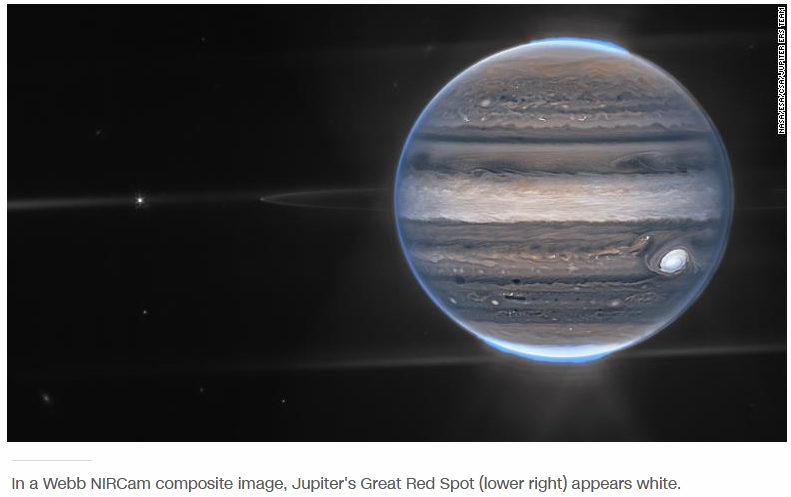In the latest images of Jupiter‘s south pole from NASA‘s James Webb Space Telescope, giant storms, rainbow auroras and far-off galaxies all appear in the largest planet in our solar system. “We hadn’t really expected it to be this good, to be honest,” said planetary astronomer Imke de Pater, professor emerita at the University of California, Berkeley, in a news release. De Pater and Thierry Fouchet, a professor at the Paris Observatory, led observations using the Webb telescope — which is itself an international endeavor by NASA with the European Space Agency and Canadian Space Agency — NASA said.
Laying out an image that moves from orange and yellow at Jupiter’s posts to blues and purples toward the middle, a few pictures from the telescope met up to shape a general composite and give Earth a glance at the gas goliath.
You can likewise see faint rings and far away worlds “photobombing” behind the scenes, as per NASA.
What’s more, Jupiter’s renowned Great Red Spot – – a tempest sufficiently large to overwhelm Earth – – seems white in these pictures.
“The various dazzling white ‘spots’ and ‘streaks’ are possible exceptionally high-elevation cloud highest points of dense convective tempests,” said Heidi Hammel, Webb interdisciplinary researcher for planetary group perceptions and VP for science at the Association of Universities for Research in Astronomy.
Researchers teamed up with resident researcher Judy Schmidt to make an interpretation of information to frame the composite pictures from the telescope, which assist with giving a superior investigate Jupiter’s life, NASA said.
‘Anything that’s out there, we will see it’ says NASA’s central goal frameworks engineer for the James Webb Space Telescope 07:01
Jupiter is difficult to convert into pictures in light of how rapidly it pivots, said Schmidt, who’s situated in Modesto, California.
“This one picture summarizes the study of our Jupiter framework program, which concentrates on the elements and science of Jupiter itself, its rings, and its satellite framework,” Fouchet said.
However, Jupiter isn’t Webb’s just subject. The space telescope is utilizing infrared light to uncover in any case imperceptible parts of the universe.
‘I’m a little verklempt’: Analyst separates shocking new Webb telescope pictures 03:50
Advancement of the world’s head space observatory started in 2004, and following quite a while of postponements, the telescope and its enormous gold mirror at long last sent off on December 25, 2021.
The telescope will take a gander at each period of vast history, including the main sparkles after the enormous detonation that made our universe and the development of the systems, stars and planets that fill it today.
The telescope is likewise finding and noticing exoplanetary frameworks, which each comprise of a planet beyond our nearby planet group and its host star.
A portion of these exoplanets are possibly livable, and looking into their air could reveal hints in the continuous quest for life beyond Earth.



